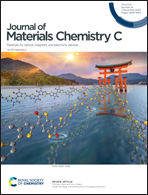Enhancing the light-emitting performance and stability in CsPbBr3 perovskite quantum dots via simultaneous doping and surface passivation†
Abstract
Inorganic perovskite CsPbBr3 quantum dots (QDs) have emerged as a promising candidate for optoelectronic applications due to their narrow emission and color purity, among other things. However, it remains a challenge to produce QDs with the desired brightness and stability. Here, a one-step synthesis with a doping agent Co(AC)2 is demonstrated to produce CsPbBr3 QDs the photoluminescence quantum yield (PLQY) and stability of which improve to almost 90% and by over 65% to 50 days, respectively. It has been elucidated by microscopy and XRD results that the Co2+ doping optimizes the quantum dot octahedron structure, indicating more passivated QD defects. As a result, LED devices using doped CsPbBr3 QDs as the luminescent layer show about 47% improvement in luminance. We postulate that, owing to the weaker electronegativity of COO− than that of Br−, the electrovalent bond on Pb is stronger, resulting in the inhibition of defect formation.



 Please wait while we load your content...
Please wait while we load your content...